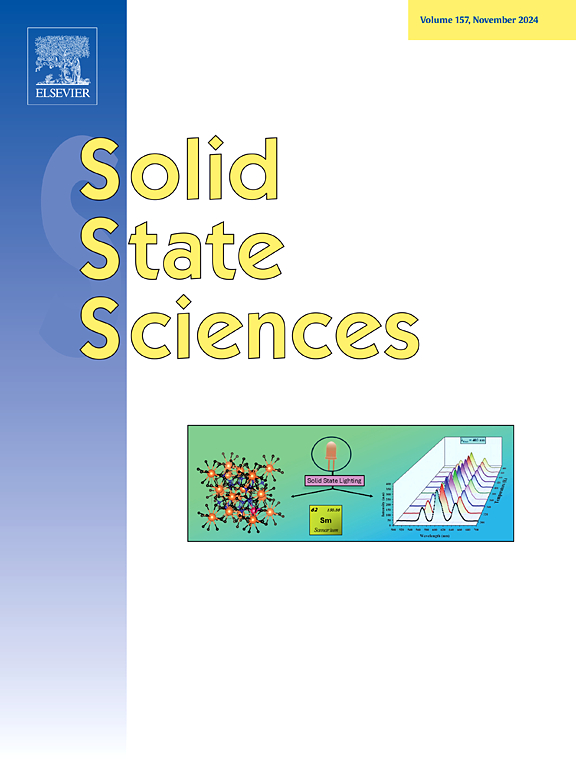NaNiFeMnO2中锆和铜双掺杂策略:提高钠离子电池的电化学稳定性和容量
IF 3.4
3区 化学
Q2 CHEMISTRY, INORGANIC & NUCLEAR
引用次数: 0
摘要
o3型层状过渡金属氧化物正极材料由于具有较高的理论容量和最佳的工作潜力,被认为是最有前途的钠离子电池正极材料之一。然而,它面临着重大的挑战,如循环稳定性差,可逆能力有限,主要是由于结构不稳定。本文成功合成了双阳离子掺杂o3型Na(Ni0.3Fe0.3Mn0.3)0.87 cu0.12 zr0.010 o2 (NaCuZrFNM)。Zr/Cu在NaFNM层状结构中的共掺杂导致了钠层的膨胀,与NaFNM相比,在充放电过程中增强了钠离子的迁移率。因此,钠离子在NaCuZrFNM中的扩散速度要快于NaFNM。结果表明,Zr/Cu双掺杂的NaFNM电极在0.1C条件下具有135.2 mA h/g的可逆放电容量和121.5 mA h/g的初始放电容量,经过250次循环后,在1C条件下的容量保持率达到81.8%。此外,在10C的高电流密度下,该材料的倍率性能为82 mA h/g,循环1000次后容量保持率为74.4%,具有良好的结构稳定性。研究结果表明,在o3型正极材料中掺杂Cu/Zr是提高钠离子电池长期性能的可行策略。本文章由计算机程序翻译,如有差异,请以英文原文为准。

Zirconium and copper dual-doping strategy in NaNiFeMnO2: Advancing the electrochemical stability and capacity for sodium-ion batteries
O3-type layered transition-metal oxide cathode materials are considered one of the most promising cathode materials for sodium ion batteries due to their high theoretical capacity and optimal operating potential. However, it encounters significant challenges, such as poor cycling stability and limited reversible capacity, primarily due to structural instability. Herein, we have successfully synthesized dual cation doped O3-type Na(Ni0.3Fe0.3Mn0.3)0.87Cu0.12Zr0.01O2 (NaCuZrFNM). The co-doping of Zr/Cu into NaFNM layered structure led to an expansion of the sodium layer, enabling enhanced sodium ion mobility during charge/discharge processes compared to NaFNM. Therefore, sodium ions demonstrated faster diffusion in NaCuZrFNM than NaFNM. It was found that the Zr/Cu dual-doped NaFNM electrode deliverers a reversible capacity of 135.2 mA h/g at 0.1C as well as 121.5 mA h/g initial discharge capacity with remarkable capacity retention of 81.8 % at 1C after 250 cycles. Furthermore, it also exhibits the good rate performance of 82 mA h/g at high current density of 10C with 74.4 % capacity retention after 1000 cycles, indicating excellent structural stability. Our results demonstrate that Cu/Zr dual-doping in O3-type cathode materials is viable strategy for improving the long-term performance of sodium-ion batteries.
求助全文
通过发布文献求助,成功后即可免费获取论文全文。
去求助
来源期刊

Solid State Sciences
化学-无机化学与核化学
CiteScore
6.60
自引率
2.90%
发文量
214
审稿时长
27 days
期刊介绍:
Solid State Sciences is the journal for researchers from the broad solid state chemistry and physics community. It publishes key articles on all aspects of solid state synthesis, structure-property relationships, theory and functionalities, in relation with experiments.
Key topics for stand-alone papers and special issues:
-Novel ways of synthesis, inorganic functional materials, including porous and glassy materials, hybrid organic-inorganic compounds and nanomaterials
-Physical properties, emphasizing but not limited to the electrical, magnetical and optical features
-Materials related to information technology and energy and environmental sciences.
The journal publishes feature articles from experts in the field upon invitation.
Solid State Sciences - your gateway to energy-related materials.
 求助内容:
求助内容: 应助结果提醒方式:
应助结果提醒方式:


